In 2009, I kayaked the 25-mile-long south coast of Menorca, the northernmost of Spain’s Balearic Islands. I had intended to circumnavigate the island but there was a strong northwest wind, called the Tramontana, crashing waves up to 15′ into the north coast and raking across the west and east coasts. I spent three days waiting for the Tramontana to weaken. With my time running out, my hosts, Maria Teresa and Carlos of Menorca en Kayak, turned me loose at Biniancolla, a coastal town on the southeast corner of the island. Trading the circumnavigation for an unhurried cruise in the sheltered south coast was the best thing that could have happened. That coast is entirely composed of eggshell-white marés limestone, a much more malleable stone than the dark gray and red crags that fortify much of the north coast. The shoreline I’d be paddling is riddled with caves carved either by the Mediterranean Sea or by hand as far back as the Bronze Age.
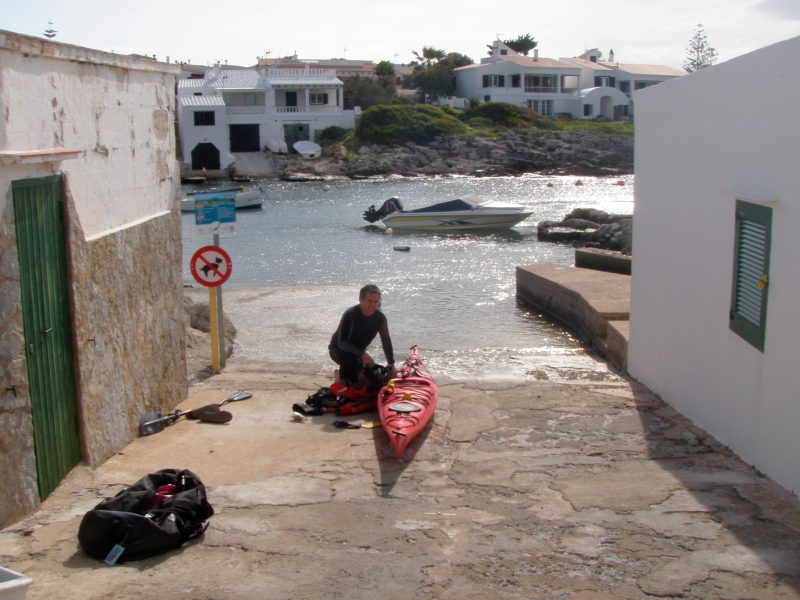
The launch ramp in Biniancolla was at the north end of a narrow, well protected cove but the Tramontana sweeping over the low landscape on the east end of the island swirled around the buildings and buffeted the water. When I left the cove and paddled west along the coast, I kept close to shore in a band of still water only a dozen yards wide.

Four miles from the launch, I found a cove with an entrance no more than 100 yards wide and its end concealed by a dogleg bend to the west. A quarter mile in, I pulled ashore here at Cala de Biniparratx, a beach nestled in a valley at the foot of a 50′-tall limestone cliff. I walked to the base of the cliff and below the largest opening here, left of center, I found steps cut into the stone that led to a cave hidden by the trees. There was a rope hanging from the largest opening that I could climb to get into that cave. There was plenty of light left for the day and I went back to the kayak and paddled 1/2 mile west to the next cove. It wasn’t nearly as interesting, so I returned to Biniparratx.

These carved steps led to the cave where I made camp. In my right hand is the rope I used to climb to the large cave higher up on the cliff face.

The cave had plenty of room and a flat floor, making it a good place to sleep, though I didn’t know at the time that the cave and those above it were burial chambers carved out of solid rock in 1st Century B.C.

There were many other ancient caves carved from the cliffs looking out over the Mediterranean. Some of them, like these, were accessible only from the high ground beyond the tops of the cliffs.

Some caves, like the one pictured here—barely visible just above the bow; also seen in the next photo— were just below sea level and repeatedly filled with water pushed in by the low swell rolling in from the south. Air trapped inside would get compressed…
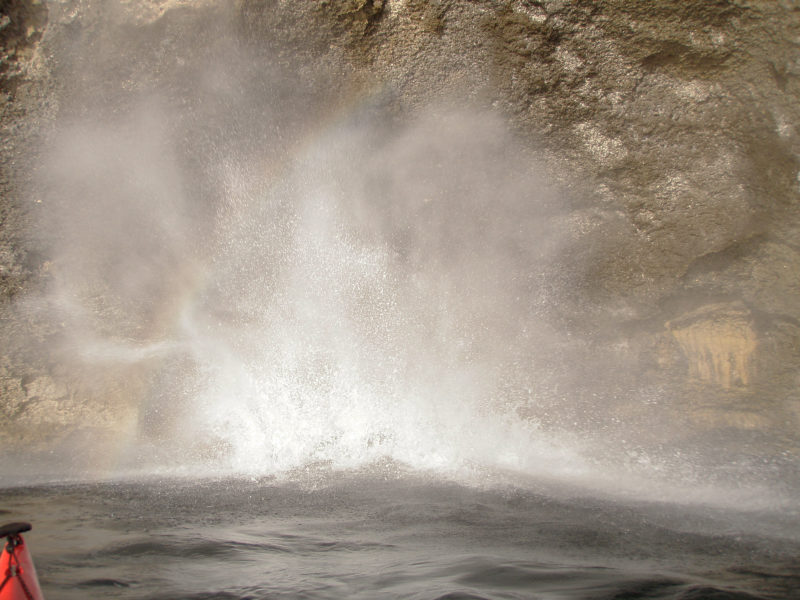
…and explode outward in a plume of spray. Other semi-submerged caves had wider openings and the air pushed out sounded like a deep sigh. Two of them led to long chambers that echoed the sound of waves rolling in, which created an unnerving sound as if someone trapped inside was moaning.
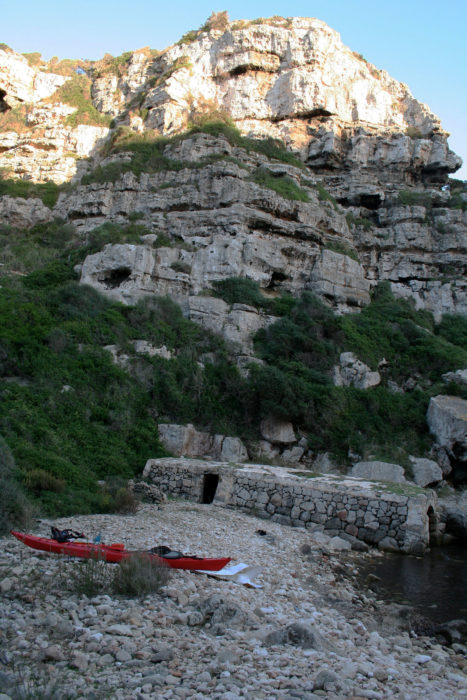
I made my second camp at Cala Sant Lorenç, a cove with sides so high and steep that my SPOT satellite messenger couldn’t get a signal out. There was an abandoned stone-walled boathouse at one end of the beach. It was filled with rubble and was rank with animal droppings, so I made my camp several yards away with my hammock stretched between two head-high rocks. Partway up the flanks of the hill to the south, I spotted two goats silhouetted at the edge of the woods; there appeared to be another cave right behind them.

In the morning I climbed the slope to where the goats had been grazing and found this cave. Inside there was a mattress, some cooking supplies, and a handle-less broom made of twigs lashed together.
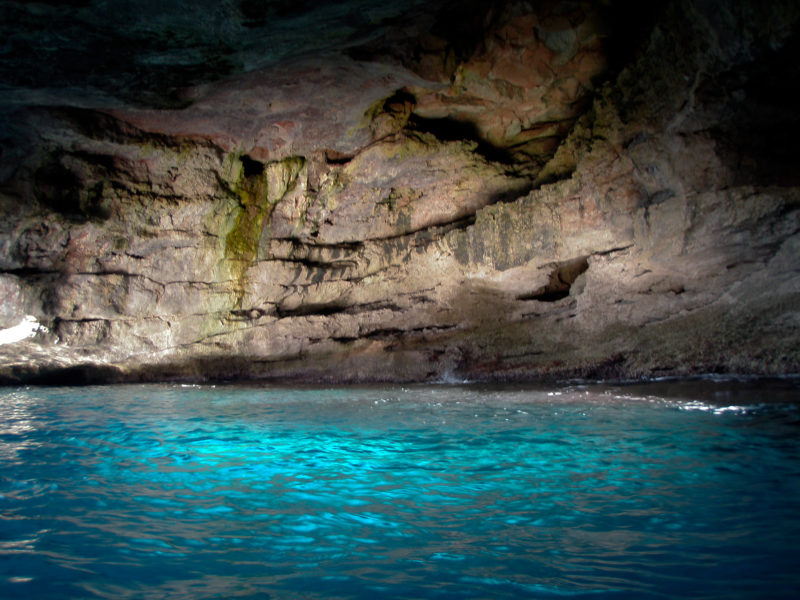
I paddled into just about every sea-level cave that was safe to enter, mindful that if there were unusually high swells that I’d need plenty of headroom to ride them out while I was in the cave. I found grottoes like this that were lit from above by gaps in the cliff and from below by light striking a white-sand bottom.

There were some caves that wove intricate paths under the cliffs and I found places where the only light came from sunlight angling under the cave walls, illuminating the white limestone sand below. I had never seen color like this before anywhere in the natural world; the only other place I’ve seen anything remotely like it is in the beads of light-blue flame that form around each hole in a butane camp-stove burner head. To be floating in that light was mesmerizing.

The stairway built on the side of this cliff had 186 steps and railings of olive wood polished smooth and shiny by countless hands. After I climbed to the top, I descended and crept through the pile of boulders at the base of the stairs with a grapefruit-size rock in hand. Large blocks of Menorca limestone ring like bells when struck. The pitch of the tone coming from a boulder wasn’t related to its size, but each had a note so clear that the slope of boulders could be set up as a musical instrument.
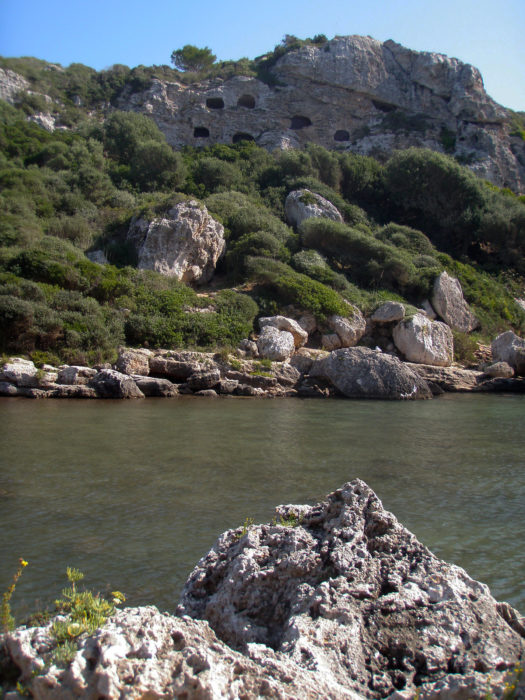
At Calas Coves there were scores of caves, some prehistoric, some with inscriptions carved into the stone in Latin. Many of the caves were for burials; Calas Coves is Menorca’s largest necropolis. I found a few caves on the east side of the inlet that were clearly living quarters with separate carved chambers for sleeping and cooking.
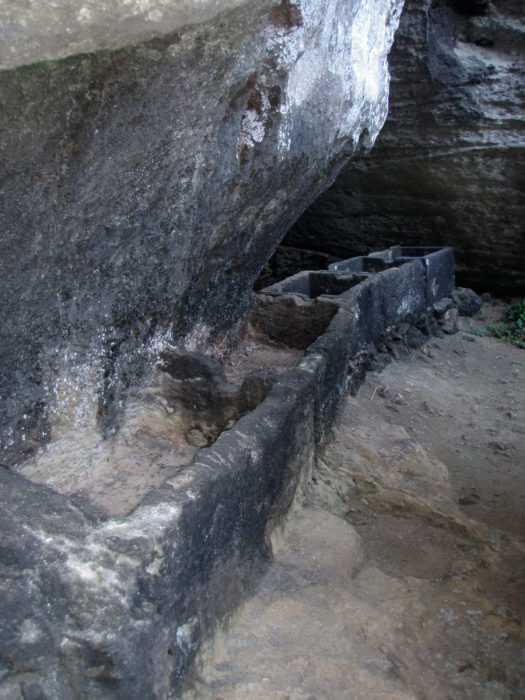
I landed on the west side of Calas Coves and hiked to the top of the cliffs. On my way up, I saw this series of carved-stone troughs, each with a recess in the top edges of the walls between them. I believe it was built to treat water. If a heavy rain picks up dirt and litter as it flows downhill, each of the troughs would let sediment settle before the water flowed into the next trough. At the end of the line, the water would be clear and the process would be faster than accumulating all the water in one container and waiting for it to become still enough for the sediment to gather at the bottom.

There was an old quarry a short walk from one of the beaches I visited. Limestone had been cut by hand for building material on Menorca since Neolithic times, but using machinery to do the job lasted only from 1960 to 1994. This quarry had three flat 35′-high vertical walls that showed marks where the cables had made precise straight cuts in the stone.
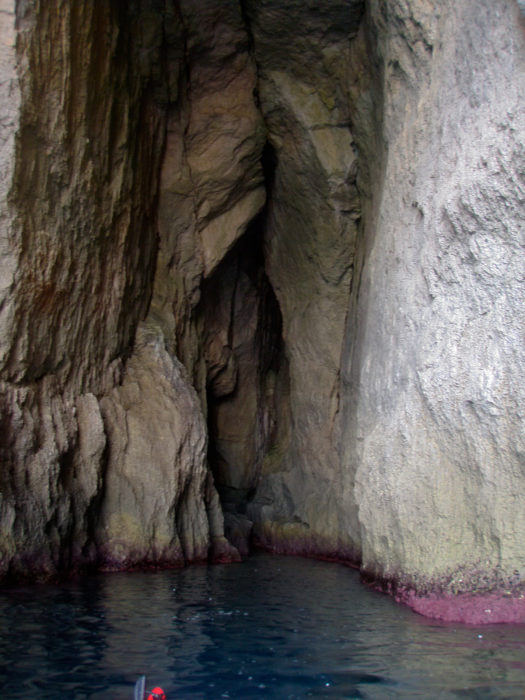
I hadn’t paddled far into this towering cave before I realized I’d need a better flashlight before continuing. I backed out and paddled west to the town of Cala Galdana to get one. With better light I paddled deeper into the cave, well past the bend in the passageway that blocked all light from the entrance.
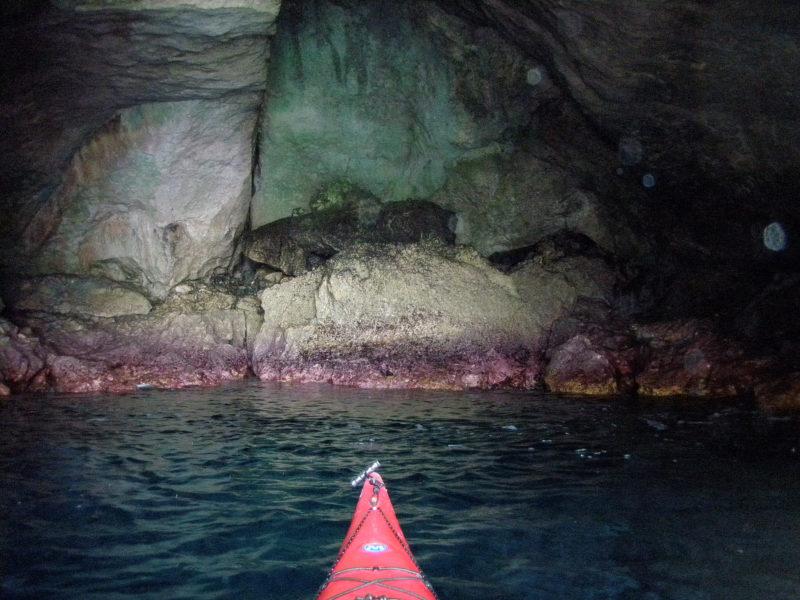
I estimated that I had paddled about 100 yards before I came to the end of the cave. The ceiling had lowered but was still high enough, a bit over 10′, to be safe if a swell pushed in. The limestone took on beautiful colors from dusty pink and purple just above the waterline to pale verdigris green overhead. The final chamber was about 25′ in diameter, large enough for me to get the kayak turned around, and when I turned the flashlight off and let the darkness envelop me, the echoes made the space sound like an empty gymnasium.

When I reached the west end of Menorca’s south coast, the Tramontana was still blowing hard and large waves were racing past the lighthouse at Cap d’Artrutx. I paddled into the harbor in the town of Cale en Bosc to wait for Carlos to pick me up. In the five days I’d had to paddle Menorca, I’d seen much more than I had ever hoped to see even if I had kayaked around the entire island.


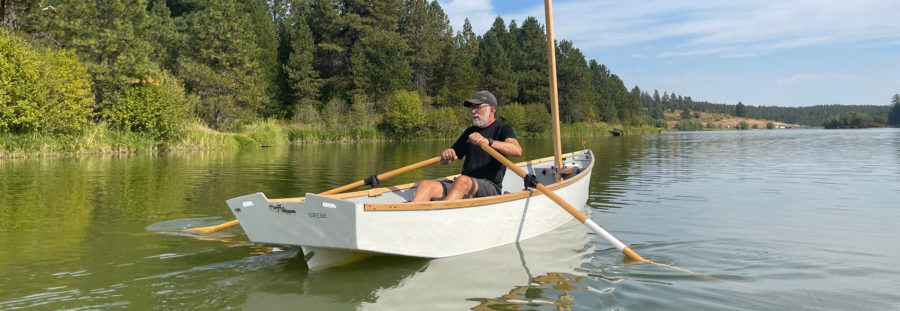
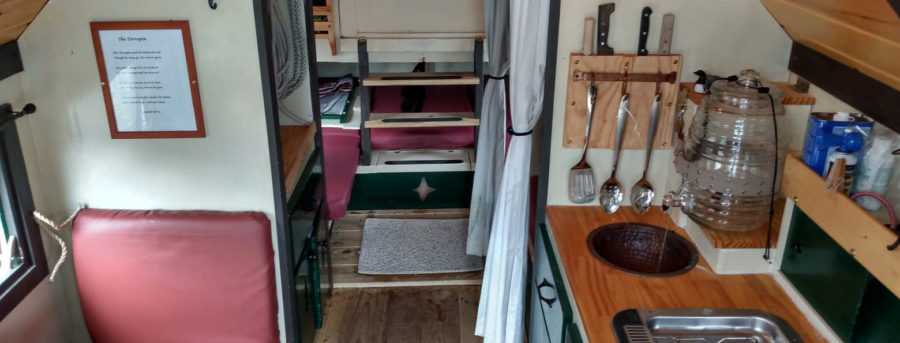


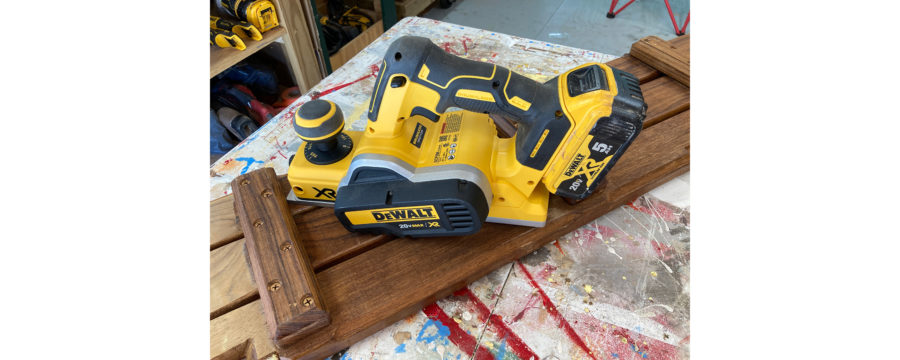
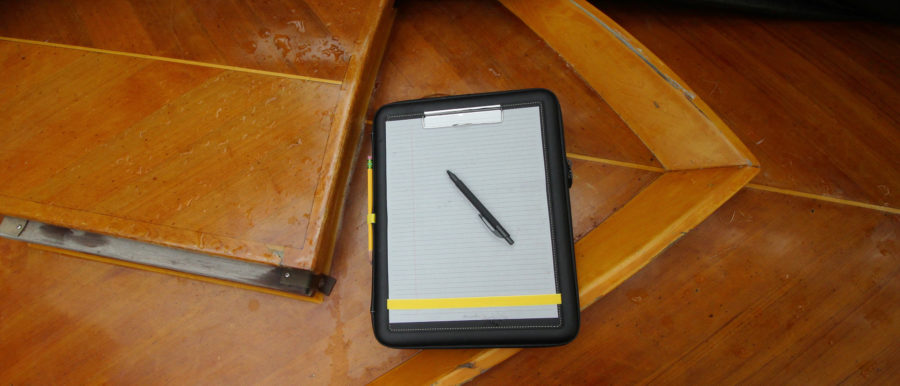
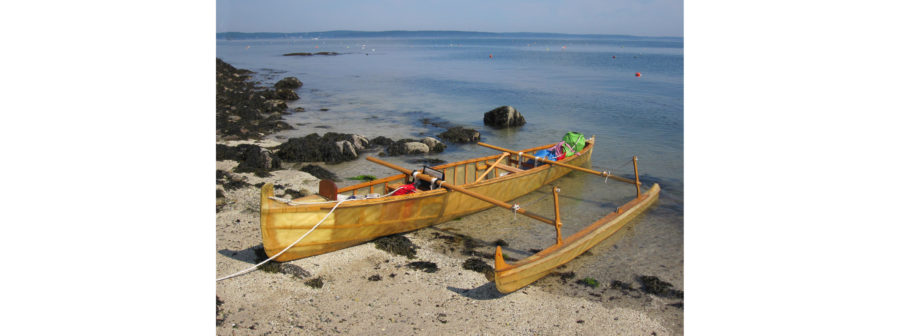
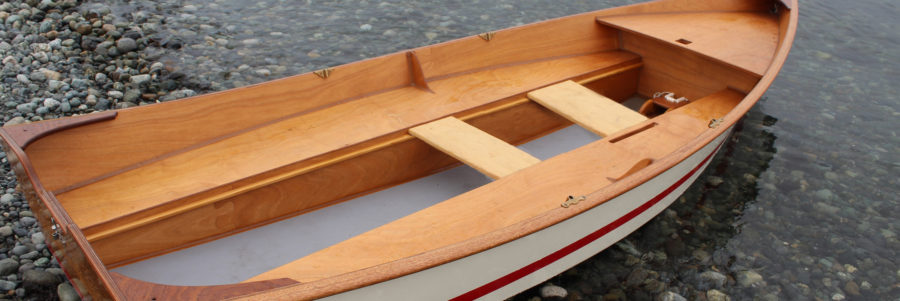
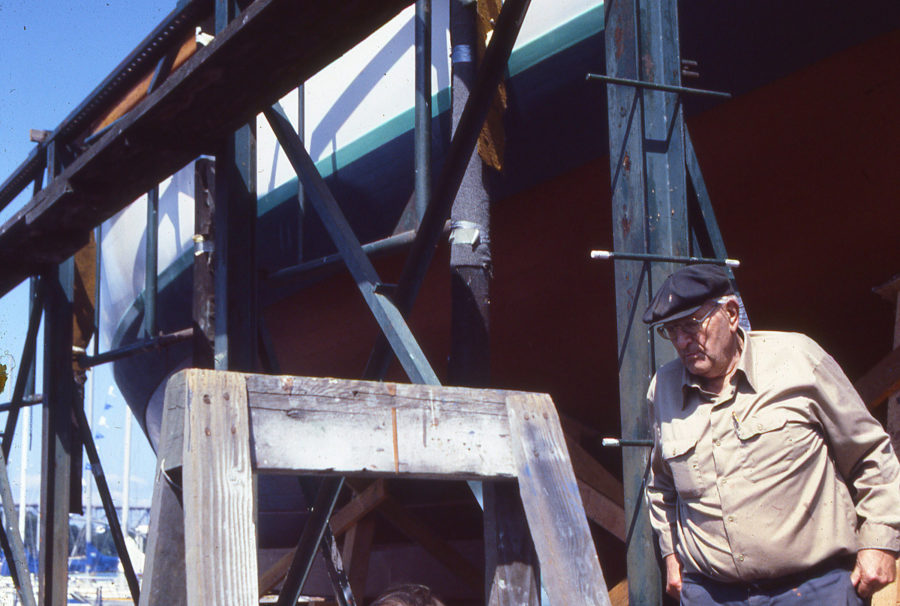
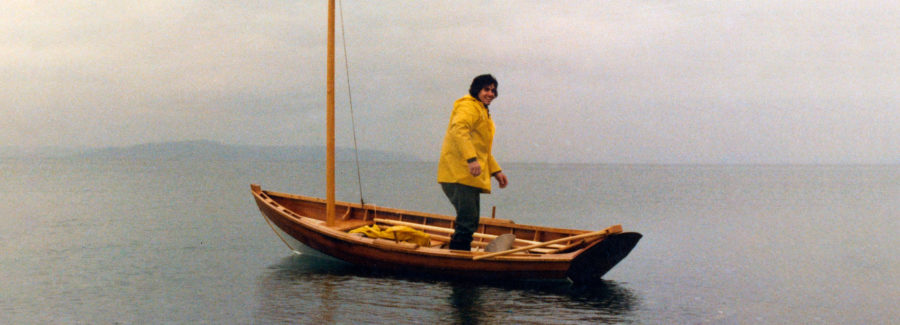
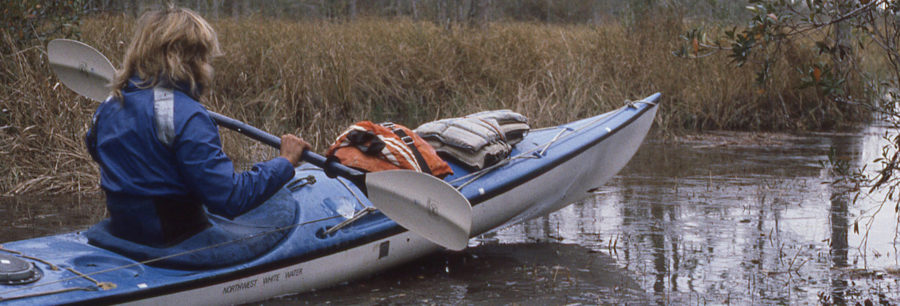
Lucky you to visit that blue-lit cave in Menorca. There is a Blue Grotto in the island of Biševo, In Croatia, but to enter you must pay the locals to take you in. Anyway, the visit is worth the price.
Once again, your photos with vivid descriptions bring the whole trip to life. Sounds, smells, and textures abound-
Love your stories, Christopher!
Wonderful narrative. Thank you.